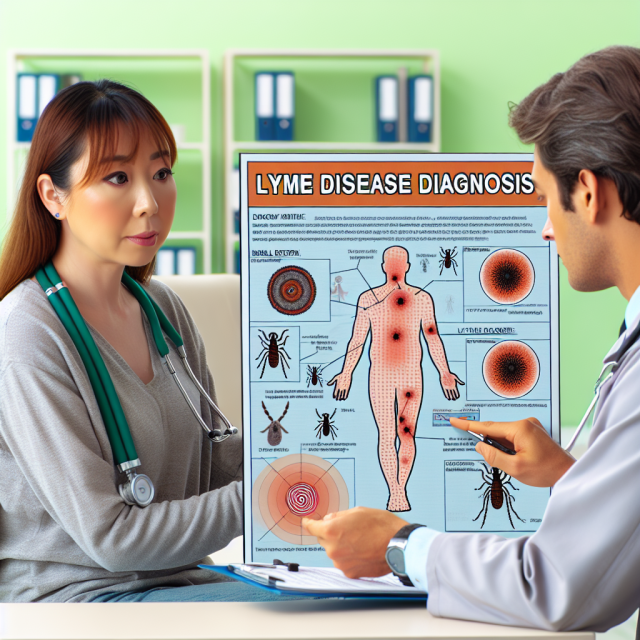
If you or someone you love has been struggling with mysterious symptoms, a Lyme disease diagnosis may feel like an overwhelming puzzle. The process can be complicated, but understanding what to look for and how testing works is crucial. Here’s everything you need to know to navigate this journey.
Table of Contents
1. What Is Lyme Disease?
Lyme disease is an infection caused by the bacterium Borrelia burgdorferi, typically transmitted through the bite of an infected tick. The sooner it’s diagnosed and treated, the better the chances of avoiding severe complications. But getting to a Lyme disease diagnosis isn’t always straightforward.
Analogy: Imagine trying to solve a puzzle with missing pieces. That’s often how patients feel when dealing with Lyme disease.
2. Recognizing Early Symptoms
Early symptoms often mimic the flu, making Lyme disease easy to overlook. Patients may experience fever, chills, muscle aches, and fatigue. One key symptom is the “bullseye” rash, also known as erythema migrans. However, not everyone gets this rash.
Tip: If you’ve been bitten by a tick or visited a high-risk area, pay close attention to these early signs.
3. Chronic Lyme Symptoms: What to Watch For
When Lyme disease isn’t caught early, symptoms can become chronic and severely impact daily life. Chronic symptoms include joint pain, severe fatigue, brain fog, and even neurological issues. This phase is where diagnosis becomes trickier.
For personal stories and community support, visit HealingWell.
4. Why Lyme Disease Is Hard to Diagnose
Lyme disease is known as “the great imitator” because it mimics other conditions like fibromyalgia, multiple sclerosis, and even depression. This overlap makes a Lyme disease diagnosis challenging and often leads to misdiagnosis.
Key Insight: Medical professionals must take a detailed history, including possible tick exposure and symptom patterns.
5. The Importance of Early Detection
Catching Lyme disease early can be a game-changer. Early diagnosis and treatment with antibiotics like Doxycycline can prevent long-term complications. Encourage patients to see a doctor immediately if they suspect they have Lyme disease.
6. Common Diagnostic Tests
Several tests are used to diagnose Lyme disease. The most common include:
- ELISA Test: Detects antibodies against Borrelia burgdorferi.
- Western Blot: Used to confirm a positive ELISA result.
Both tests are part of the standard two-tier testing method.
7. The Two-Tier Testing Approach
The two-tier testing approach involves an initial ELISA test followed by a Western Blot if the ELISA is positive. While this method helps reduce false positives, it’s not perfect.
Why It’s Flawed: Antibodies can take weeks to form, meaning early infection may not show up on these tests.
8. Limitations of Current Testing Methods
One of the biggest frustrations for patients is that the current tests aren’t foolproof. False negatives are common, especially in the early stages. Some patients require more advanced testing, like PCR tests or newer research-based methods.
External Resource: For more on advanced testing, check out this CDC article.
9. What to Expect During a Doctor’s Visit
During a consultation, doctors typically perform a physical exam, review your symptoms, and ask about any potential tick exposure. Be prepared to share as much detail as possible. It helps paint a clearer picture.
Practical Tip: Bring a list of symptoms and questions to make the most of your visit.
10. How to Advocate for Yourself
Navigating a Lyme disease diagnosis can be exhausting. Don’t be afraid to seek second opinions or ask for additional tests. You know your body best, and your voice matters.
Supportive Note: Finding the right doctor can make all the difference. Look for a healthcare provider experienced in treating Lyme disease.
For more in-depth articles and resources, visit Health at HealingWell.
Conclusion
Understanding the path to a Lyme disease diagnosis is the first step toward effective treatment. While the road may be filled with uncertainties, staying informed and proactive can make a significant impact. You’re not alone in this fight, and there’s a community ready to support you.
FAQs
1. How soon after a tick bite should I get tested for Lyme disease?
It’s best to wait a few weeks for accurate antibody testing. However, see your doctor immediately if you develop symptoms.
2. Can Lyme disease be cured if caught early?
Yes, early treatment with antibiotics is often very effective. Chronic symptoms are more difficult to manage.
3. What should I do if I get a false negative test result?
Discuss retesting with your doctor or consider more advanced testing methods, especially if symptoms persist.
4. Are there any new tests for Lyme disease on the horizon?
Yes, researchers are working on more accurate and faster diagnostic tools. Stay updated with reputable sources like the CDC.
5. How can I support a loved one dealing with Lyme disease?
Offer emotional support, stay informed, and encourage them to seek the best medical care available.
For more support and information, visit HealingWell.





